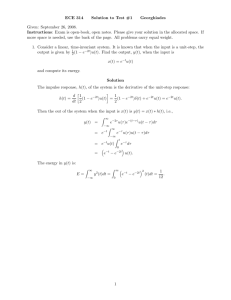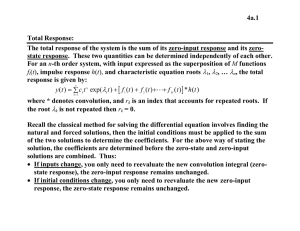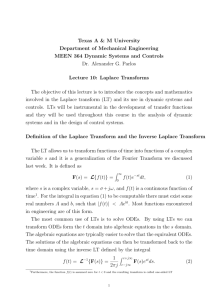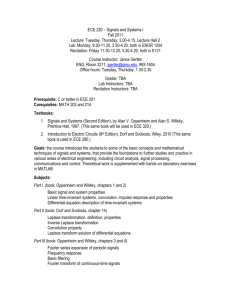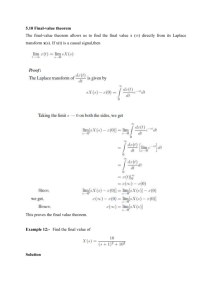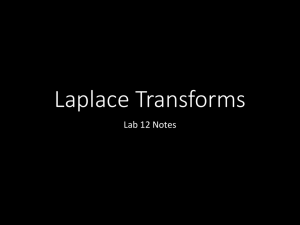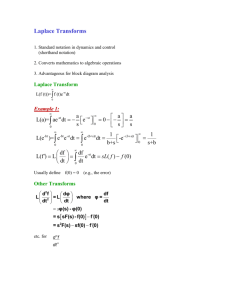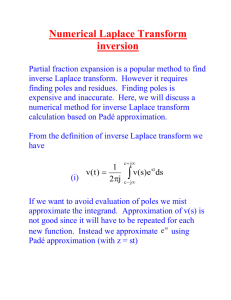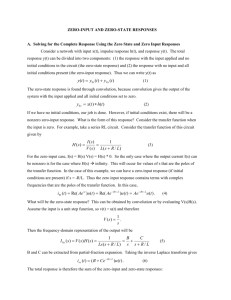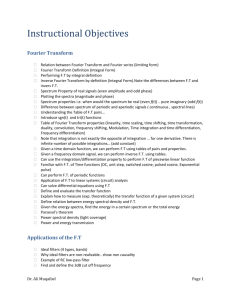Chapter13
advertisement
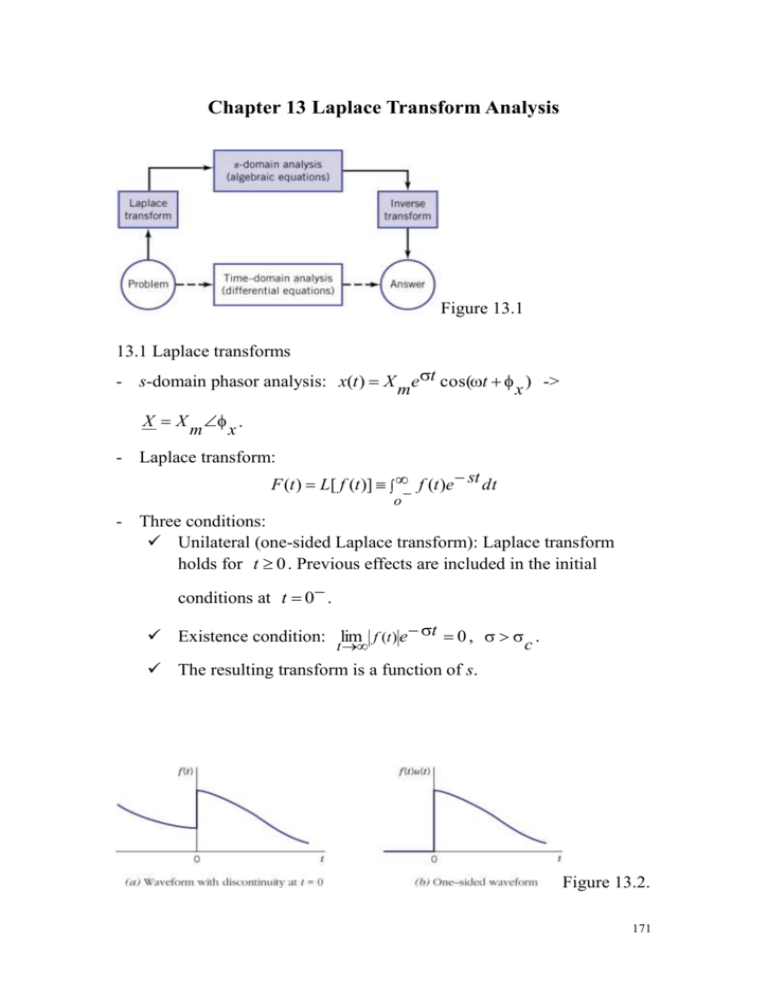
Chapter 13 Laplace Transform Analysis Figure 13.1 13.1 Laplace transforms - s-domain phasor analysis: x(t ) X met cos(t x ) -> X X m x . - Laplace transform: F (t ) L[ f (t )] f (t )e st dt o - Three conditions: Unilateral (one-sided Laplace transform): Laplace transform holds for t 0 . Previous effects are included in the initial conditions at t 0 . Existence condition: lim f (t ) e t 0 , c . t The resulting transform is a function of s. Figure 13.2. 171 - Inverse Laplace transform for t 0 : f (t ) L 1[ F (s)] 1 c j st c j F ( s)e ds , c c . 2j - Inverse Laplace transform is usually done by partial fraction expansion (will be covered in section 13.2). Example 13.1 Figure 13.3. 172 Example 13.2 - Transform properties: Linear combination: Multiplication by e st : Multiplication by t: Time delay: Figure 13.4. 173 Differentiation and integration: Example 13.3 Figure 13.5. Example 13.4 (Please refer to Tables 13.1 and 13.2.) 174 - Solution of differential equations using Laplace transform: The transformation automatically incorporates the initial conditions. Transformation converts linear differential equations to s-domain algebraic equations. Transformation is similar to the s-domain phasor analysis. Denominator of the s-domain function includes the characteristic polynomial. Inverse transformation is required to obtain the resultant time domain function. First-order example: Figure 13.6. 175 Second-order example: Figure 13.7. 13.2 Transform inversion - Partial-fraction expansion of a strictly proper rational function m m 1 b s b N (s) bm s bm 1s 1 0 , m n 1. F ( s) n n 1 D( s ) s a s a s a n 1 1 0 - Three cases will be considered: distinct real poles, complex poles and repeated poles. - Case 1: distinct real poles (Heaviside's theorem, cover-up rule.) 176 Example 13.5: Inversion of a Third-Order Function I s 2 ( R / L) I s I / LC 1 2 I ( s) 1 s s 2 ( R / L)s 1 / LC - Case 2: complex poles D(s) (s 2 2s 2 )(s s )(s sn ) 0 3 177 Example 13.6: Inversion with Complex Poles (method of the undetermined coefficients) 15s 2 16s 7 F ( s) (s 2)(s 2 6s 25) 178 - Case 3: repeated poles A A 3 F ( s) G ( s) n ss ss n 3 A A i 1 i2 G ( s) s s (s s ) 2 i i Example 13.7: Inversion with a Triple Pole s 2 2s 14 F ( s) (s 4)3 (s 5) 179 - Tim delay Example 13.8: Inversion with Time Delay - Initial-value theorem Figure 13.8. 180 - Final-value theorem Example 13.9: Calculating Initial and Final Values N ( s) 5s 3 1600 f (0 ) 5 , F (s) D(s) s(s 3 18s 2 90s 800) 181 13.3 Transform circuit analysis - Given a circuit with some initial state at t 0 and an excitation x(t ) starting at t 0 , find the resulting behavior of any voltage or current y(t ) for t 0 . - Zero-state response, natural response, forced response, zero-input response and complete response. - Zero-state response: a circuit with no stored energy at t 0 . - Step response: x(t ) u(t ) 1, t 0 X ( s) 1 / s 1 N ( s) Y ( s) H ( s) H s sP(s) 182 Example 13.10: Step Response Figure 13.9. - Zero-state AC response: x(t ) X m cos(t x ) D ( s) s 2 2 X 183 Example 13.11: Zero-State AC Response Figure 13.10. - Natural response and forced response: 184 - Zero-input response: the excitation equals zero for t 0 but the circuit contains stored energy at t 0 . Figure 13.11. Figure 13.12. 185 Example 13.12: Calculating a Zero-Input Response Figure 13.13. - Complete response: complete response=zero-input response + zero-state response. Example 13.13: Calculating a Complete Response Figure 13.14. 186 Figure 13.15. 13.4 Transform analysis with mutual inductance Figure 13.16. Figure 13.17. 187 Example 13.14: Complete Response of a Transformer Circuit Figure 13.18. 188 13.5 Impulses and convolution - Impulses: Figure 13.18. Figure 13.20. 189 - Sampling process: Example 13.15: Discontinuous Inductor Current Figure 13.21. 190 - Transform with impulses L (t ) (t )e st dt e st 1. 0 t 0 - As an example, the inverse transform of 3s is s2 - In general, the inverse of F (s) n n 1 b s b N (s) bn s bn 1s 1 0 F ( s) n n 1 D( s ) s a s a s a n 1 1 0 191 Example 13.16: Impulsive Zero-State Response Figure 13.22. - Convolution and impulse response. - The convolution of f (t ) and g (t ) : f (t ) g (t ) f () g (t )d . - Commutative property ( f (t ) g (t ) g (t ) f (t ) ): - Distributive property ( f (t ) g1 (t ) g 2 (t ) f (t ) g1 (t ) f (t ) g 2 (t ) ): - Replication property ( f (t ) (t ) f (t ) ): 192 - Graphical interpretation: Figure 13.23. Figure 13.24. 193 - Convolution of two causal functions produces another causal function. - Laplace transform of the convolution of causal functions: L f (t ) g (t ) F (s)G(s) L- 1F ( s)G ( s) f (t ) g (t ) Figure 13.25. 194 Example 13.17: Impulse Response and Pulse Response Figure 13.26. Figure 13.27. 195
